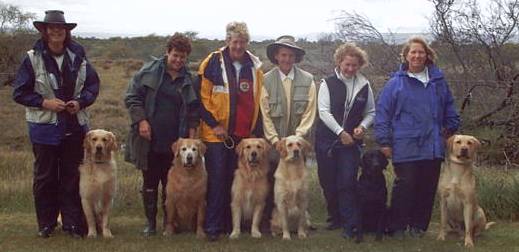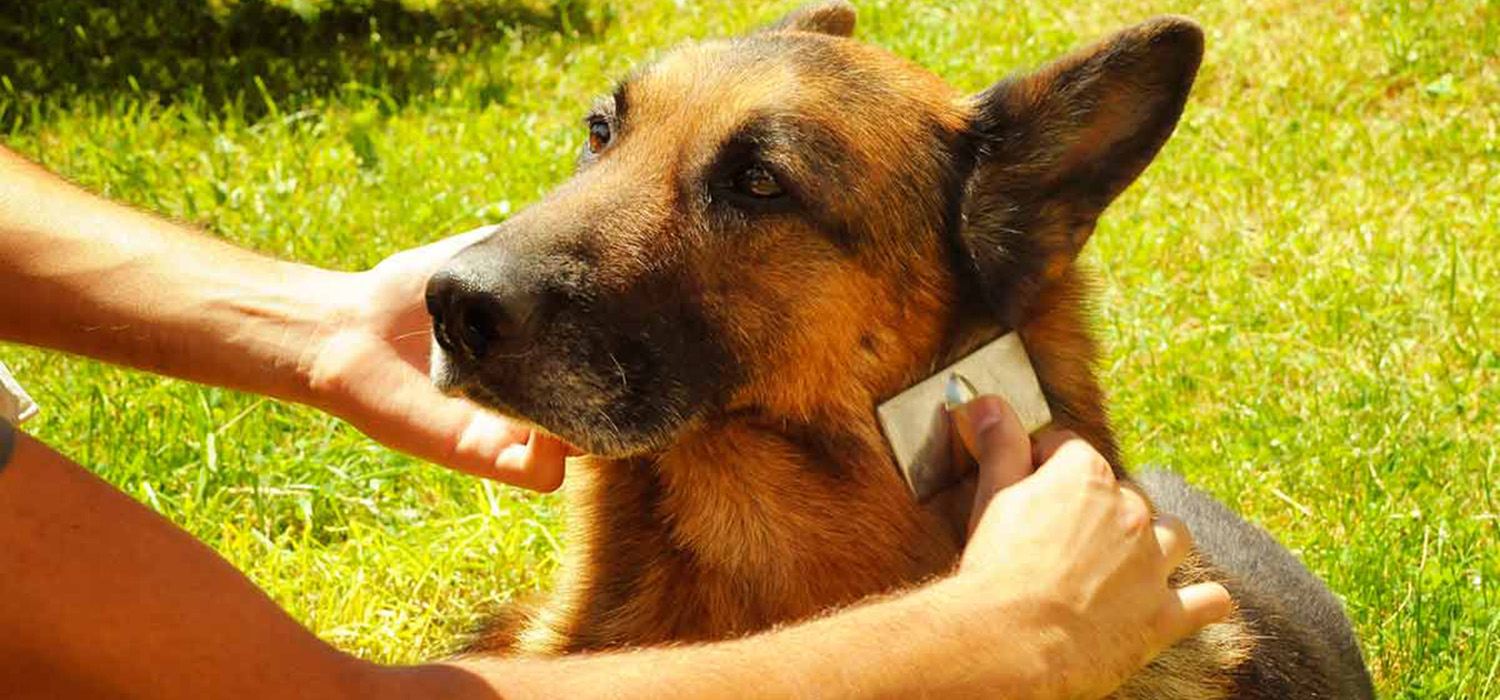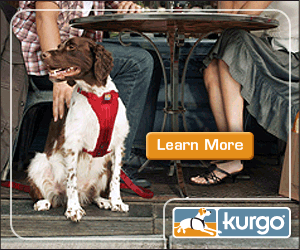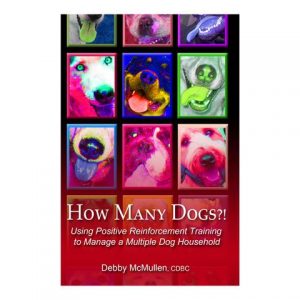 Dog training is a critical requirement of owning a dog! All dogs need to be trained, regardless of their breed and age, so they can fit into our society. Dog training clubs and instructors are readily available, however some are much more effective than others so it is important to do a little research and find out which are the ones that you feel most comfortable with before committing your money to their classes. It is becoming more recognizable that dog training and obedience clubs and schools which use praise and positive reinforcement methods are the ones with the most effective results. A happy dog means there will be a happy handler on the end of the leash.
Dog training is a critical requirement of owning a dog! All dogs need to be trained, regardless of their breed and age, so they can fit into our society. Dog training clubs and instructors are readily available, however some are much more effective than others so it is important to do a little research and find out which are the ones that you feel most comfortable with before committing your money to their classes. It is becoming more recognizable that dog training and obedience clubs and schools which use praise and positive reinforcement methods are the ones with the most effective results. A happy dog means there will be a happy handler on the end of the leash. Harsh punishment methods of training can not only make a dog unhappy but can also be cruel. Some dog training collars, for example the prong collar, have the capacity to do some permanent damage to a dog’s neck if not used correctly, and yet there are some dog trainers who still advocate their use.
Harsh punishment methods of training can not only make a dog unhappy but can also be cruel. Some dog training collars, for example the prong collar, have the capacity to do some permanent damage to a dog’s neck if not used correctly, and yet there are some dog trainers who still advocate their use.Positive Reinforcement Training
Positive Reinforcement Training simply means that you reward for the behavior that is desired and ignore any behavior which is not desired. Dog training based on positive reinforcement is sometimes misunderstood and taken to mean that it is only about giving food and treats to the dog when a desired behavior happens or using food to instigate the required behavior (commonly known as a bribe). This is actually not quite correct. Anything that the dog or puppy desires can be used as a reinforcer. For example, many dogs love to chase a ball, therefore throwing a ball for the dog to chase after he has been quietly lying at your feet is a classic example of positive reinforcement training. Favorite toys, walks, play sessions, pats and attention – anything that the dog is motivated by can be used as a primary reinforcer. Allowing a dog to go free and sniff around can be a great reinforcer after a minute of lovely loose lead walking, is another example. The Quick Draw Leash from Ruffwear.com is a leash that can be worn around a dog’s collar when not in use. Enjoy off-leash freedom with the option of a short restraining leash when needed. The Quick Draw clips onto any collar and wraps around the dog’s neck, securing with a hook and loop closure. Pull the tab to go from off-leash to on-leash. Find out more here!
Dogs will learn faster and more effectively using positive reinforcement dog training principles. The most important thing is to not to have too high an expectation from the dog when you first start training any particular exercise. Break each behavior down into small parts and make them achievable. For example, if you are starting to train your dog to sit and stay don’t expect that the dog will stay for 10 minutes with you being at a 10 metre distance away in the first lesson. Train the dog to stay for just a few seconds with you in front of the dog on the first lesson and then gradually, over a period of lessons, build up to the point where your dog will sit and stay for 20 seconds with you being a pace away.
The thing with positive reinforcement training is that it needs to be consistent and timing of the reinforcement needs to be precise. It takes skill to be able to implement effective and positive dog training methods and patience is definitely required. Karen Pryor Clicker Training has the best resources for positive reinforcement dog training. As the dog learns the exercise you are training for, you then reduce the reinforcement in a gradual process until it is no longer required. This is the mistake that many people make, of not fading out the reinforcement which results in the dog only performing the behavior in the presence of food.
Take a walk on the flipside with The Other End of the Leash: Why We Do What We Do Around Dogs. A revolutionary, new perspective on relationships with dogs, this book focuses on the human behavior in this dynamic pairing—instead of the other way around. An applied animal behaviorist and experienced dog trainer, Dr. Patricia McConnell looks at humans as just another interesting species, and muses about why we behave the way we do around dogs, how they might interpret that behavior, and how to interact with dogs in a way that brings out their very best.
Because ultimately, humans and dogs are still two entirely different species, each shaped by individual evolutionary heritage—quite simply, humans are primates and dogs are candids (like wolves and foxes). Since both speak in a different native tongue, much gets lost in translation. Once you start to think about your own behavior from the viewpoint of your dog, you’ll understand much of what appears to be disobedience is simply miscommunication. This book teaches how to use your voice; why “getting dominance” over your dog is a bad idea; why “rough and tumble” play can lead to trouble and how to play; and how dogs and humans share personality types. Striving to help you make the most of your life with your dog, the author combines wonderful true stories with scientific perspective in her own insightful, compelling style.
Clicker Training
Clicker Training is becoming more and more popular. The clicker is a very distinct short, sharp sound and when given at the exact time the desired behaviour. Firstly, that sound is simply paired with a high value dog treat. The dog then makes the association that every time the click happens a treat is forthcoming. Once that association is made then you click for specific behaviors that the dog performs. The dog very quickly learns to repeat those behaviors in order to get the treat. Once the dog has learnt the behavior it is then possible to fade out the click and put a word to replace it. Reinforcement becomes very intermittent and this actually strengthens the behavior you are working on, as the dog never knows when that random treat is going to be forthcoming. Think about why people become gambling addicts – addiction is based on the very same principles – intermittent reinforcement! This is a great way of training your dog as you have no need to use your voice, therefore there is no emotion coming into the training. There is no need to scream or shout and you don’t need to get upset if the dog doesn’t do what you want. Why not get started straight away with a Getting Started Clicker Training Kit from Karen Pryor’s Clickertraining.com?
Clicker training is a science and it definitely takes some skill to master so you need to seek out the services of dog training instructors who have qualifications and experience. Anyone can click and treat – the mastery is in the timing and the degree of accuracy of the behavior you are trying to achieve to improve performance.
Karen Pryor is the person who introduced clicker training to the dog world. Clickers were initially used to train marine animals as there was no other way of training animals in marine parks. Karen used to be a dolphin trainer and used the same principles to training dogs. The clicker is just another tool – it is the principles that are important. You can find an amazing number of resources at her website Karen Pryor Clickertraining!
Training a Puppy vs. Training an Older Dog
There is a big difference in training an 8 week old puppy (refer to our Puppy Training page) to a fully grown adult dog that comes from a rescue shelter. A puppy is a clean slate and with professional positive training dog classes and instructors means you can train a puppy with minimal problems. A rescue dog already has a baggage of established behaviors which may or may not be appropriate behavior and this will take a different set of dog training understanding and abilities to rectify and modify these behaviors into more desirable ones.
Training a puppy ideally will start from the breeder – they will already have been exposing the puppy to some socialization exercises. Before you even bring the puppy home, do some research and find a quality puppy pre-school where the instructors have been specifically trained to run effective puppy classes. Ask for their qualifications and experience, ask to observe the class and if you are happy with what you see then make a booking. When you first bring home that puppy give it a few days to settle in and then take it along to puppy pre-school. The 8 to 12 week age of a puppy is a critical time for socialization and many basic training behaviors can be established effectively in these first weeks. Then continue your training through a dog club or private classes for as long as possible – the longer, the better!
Training an older dog which has been owned by someone else may not have been trained during puppyhood and therefore established unwanted behaviors may need modifying. It is possible to do this, however you may need the expertise of a more experienced trainer. Depending on the dog’s behavior, it may be necessary to have private classes to begin with to iron out some of the problems. An effective instructor will be able to tailor a training program specifically for you and your dog. Integration into group classes may be possible once the initial ground work has been done. This also will take time and patience on your part.
Would you like to live in harmony in a house with multiple dogs? Harmony can most easily be obtained when non-force training techniques are used, along with proper living-space management and good feeding habits. You’ll learn how to do all those things in How Many Dogs?! You’ll also learn techniques for adding new dogs, group training and exercise, playtime, resolving issues with problem dogs, and all the other things you need to know to guide you through your life with multiple dogs. Throughout the book there are examples of real life experiences of people using these techniques. Whether you live with two dogs, six dogs, or more, How Many Dogs?! will help bring more joy into your home. Available now from Karen Pryor’s Clicker Training Store!
“As a trainer who lives with a relatively large pack of dogs, I appreciate the down-to-earth, positive approach to pack management in Debby’s book. Debby has succeeded in providing both a moral support system and a user-friendly plan for people struggling with the multiple dog lifestyle, as well as giving helpful tips for integrating foster dogs or the new puppy. If you are feeling a little out of control in your multiple dog household, this book provides support from somebody who has not only “been there” herself but made a career out of it.” –Leslie McDevitt, MLA, CPDT, CDBC, author Control Unleashed
Some Tips for Training
- Do not train your dog if you are not in a good mood! The reason? Dogs pick up on vibes and will not work as well if they sense tension or stress. BEWARE – don’t make this a regular excuse for not doing any dog training, though! The dog is going to require time and effort on your part if you want it to grow into a well socialized and well behaved pet – consistent training is the only way to achieve that.
Do you have limited time to spend training your dog? Find out how to make the most of the minutes you have together, using your limited time wisely. The book contains exercises throughout and provides an online support community you can engage in teaching and learning.
Via clear communication, start to build your ten minute a day habit into your routine. Reducing stress and maximizing effective training exchanges yields more quality time interacting with your dog. This book can be found at the Karen Pryor Clicker Training online shop!
2. Your dog training is best started from the day you bring him home. You want to begin to establish the rules from the start and then your puppy will start to get his position in the pack. Dogs are a pack animal and your family is their pack. Establish their rank through dog training quickly by teaching them very simple commands and rewarding for correct behavior. Also show the children how to request simple commands from the dog – sit, for example. But don’t tell your puppy sit, sit, sit and keep repeating the voice command with no action. Best to wait for the puppy to offer the behavior ‘sit’ position and then giving the voice command ‘sit’ while the action is taking place. Then immediately afterwards he gets a treat as a reward for good behavior. You have just set your puppy up for rewarding and winning behavior! If you keep repeating a command a few times over and the dog doesn’t respond to this command (because he doesn’t speak English), your dog training is teaching him to ignore you as you are speaking as no action is happening on the dog’s part. This goes for any type of behavior you are bringing into your dog training schedule.
“From the endlessly inventive Kay Laurence, here’s a whole collection of new games for the clicker dog and owner. The focus of the games ranges from simple targeting to modified hunting skills and highly specific movement patterns. These training exercises develop not just the behavior itself, but attributes and skills such as self-confidence, focus, strength, flexibility, spatial awareness, balance, and self control—and not just for the dog, but also for the handler. Whatever your training goals, this book will enrich and expand your training, and provide all kinds of new indoor and outdoor excitement for you and your dog.” -Karen Pryor
Available from Karen Pryor’s Clicker Training Store!
3. Another thing to remember that your young puppies have the attention span of a flea! So make your dog training session brief and no more than five minutes at a time. But if you have the chance to do a few minutes at a time throughout the day this will reinforce the behavior you want from the dog. Constant repetition is the key! Your puppy or dog training should be bright and happy and fun for you both. Always finish on a positive note, and preferably do a puppy training session just before it is his meal time and use the meal for a reward.

BRAVO! Dog Training Treats are the perfect way to reward your dog!
Bravo! Bonus Bites are an extensive line of freeze-dried and dry-roasted, all-meat treats. They use only antibiotic-free poultry, fresh fish and grass-fed red meats in these healthy, all-natural, grain-free snack. If you have made the commitment to feed your pet better healthier food, you should consider including all natural treats in that plan. Why? If you are like most pet owners you feed your pet a lot of treats, every day, and it is important the treat be as healthy as their daily meal. Bravo! Bonus Bites are 100% all meat, and made from all natural, antibiotic-free, grain free meats and organ meat protein sources. Available now at Chewy.com!
4. PRAISE, PRAISE, PRAISE for correct behavior – using voice, pats or treats. Remember, though, when you are training and treating your dog for correct behavior to account for this when it comes to meal time – see dog feeding. You still need to be wary about overfeeding.
Available from the Clickertraining.com Store!
What exactly is a Do Over Dog? It might be a shelter dog you’re working with to help become more adoptable. Perhaps it’s the dog you’ve adopted, rescued, or even found running stray that is now yours to live with and love… forever. Or, it could be the dog you’ve lived with for years but realize still has issues that make him a challenging canine companion. A Do Over Dog is any dog that you think needs—make that deserves—a second chance in life.
Noted author and trainer Pat Miller has spent her life working with both people and dogs—shelter dogs, family dogs, and dogs with behavior problems. In her newest book she shares the wisdom of her years in the field of force-free, positive dog training to help give people and pets a first class life together.
Karen Pryor says, “Do Over Dogs offers good advice about adopting a dog with any behavior issues. Give a copy to friends and relatives before they go to the shelter.”
5. Effective dog training is an art and it is far better to seek out a professional dog trainer with plenty of experience. A lot of dog trainers become instructors at clubs because of having had difficult dogs themselves so they do understand what you are going through, particularly if you have a rescue dog which is a little more difficult. With some patience and perseverence you will succeed..
.












